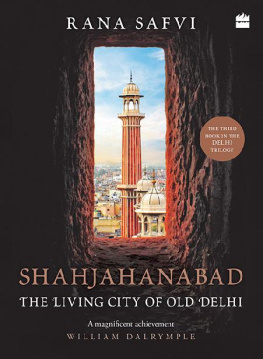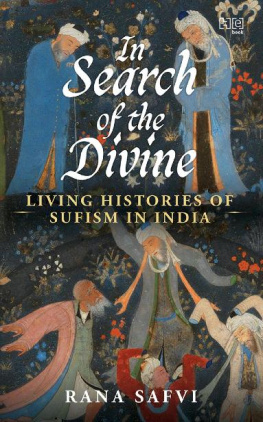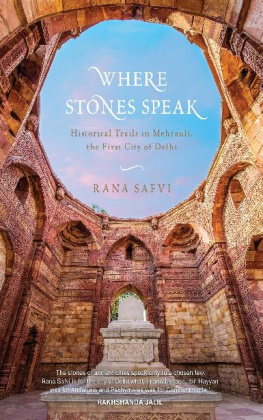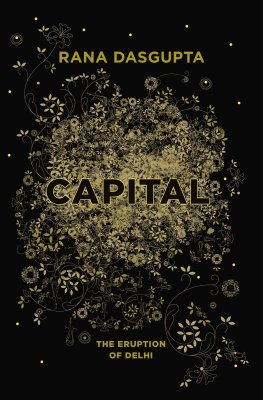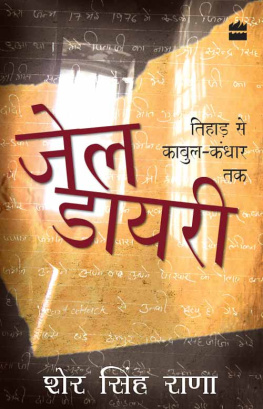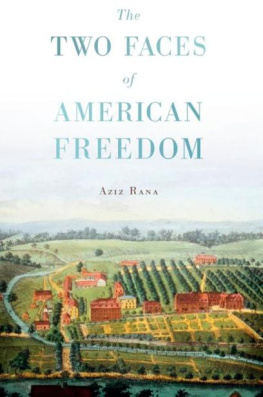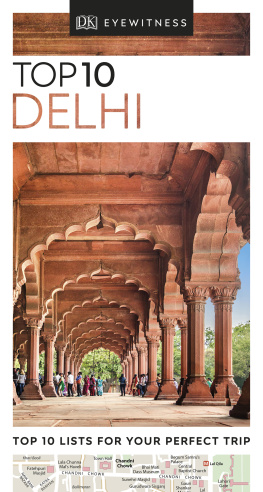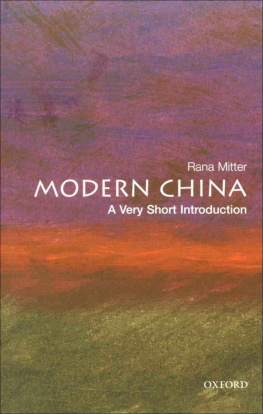Rana Safvi - Shahjahanabad: The Living City of Old Delhi
Here you can read online Rana Safvi - Shahjahanabad: The Living City of Old Delhi full text of the book (entire story) in english for free. Download pdf and epub, get meaning, cover and reviews about this ebook. year: 2019, publisher: HarperCollins Publishers India, genre: Religion. Description of the work, (preface) as well as reviews are available. Best literature library LitArk.com created for fans of good reading and offers a wide selection of genres:
Romance novel
Science fiction
Adventure
Detective
Science
History
Home and family
Prose
Art
Politics
Computer
Non-fiction
Religion
Business
Children
Humor
Choose a favorite category and find really read worthwhile books. Enjoy immersion in the world of imagination, feel the emotions of the characters or learn something new for yourself, make an fascinating discovery.
- Book:Shahjahanabad: The Living City of Old Delhi
- Author:
- Publisher:HarperCollins Publishers India
- Genre:
- Year:2019
- Rating:3 / 5
- Favourites:Add to favourites
- Your mark:
- 60
- 1
- 2
- 3
- 4
- 5
Shahjahanabad: The Living City of Old Delhi: summary, description and annotation
We offer to read an annotation, description, summary or preface (depends on what the author of the book "Shahjahanabad: The Living City of Old Delhi" wrote himself). If you haven't found the necessary information about the book — write in the comments, we will try to find it.
Rana Safvi: author's other books
Who wrote Shahjahanabad: The Living City of Old Delhi? Find out the surname, the name of the author of the book and a list of all author's works by series.
Shahjahanabad: The Living City of Old Delhi — read online for free the complete book (whole text) full work
Below is the text of the book, divided by pages. System saving the place of the last page read, allows you to conveniently read the book "Shahjahanabad: The Living City of Old Delhi" online for free, without having to search again every time where you left off. Put a bookmark, and you can go to the page where you finished reading at any time.
Font size:
Interval:
Bookmark:

For Subuhi Safvi
Tu shaheen hai parvaaz hai kaam tera
Tere saamne aasmaan aur bhi hai
You are an eagle, keep on soaring (higher and higher)
There are many skies beyond this for you
ALLAMA IQBAL
Ye shehr buland aalam-e baala se thha
Humshakl gharaz jannat-e maawa se thha
Ab kya hai ik aabaadi-e registaan hai
Dehli ko sharaf qile mualla se thha
This city was higher than the heavens once
In beauty, it resembled the paradise once
Now its nothing but an inhabited desert
Delhis soul was its exalted fort.
GHULAM MAULA QALAQ
CONTENTS
)
)
)
)
By the time Emperor Shah Jahan ascended the throne of the Mughal Empire in February 1628, the empire had expanded and the darbar (public court) was attended by many rajas and umara (nobles and grandees). Two factors influenced his decision to shift his capital from Agra: one was that the Agra Fort, from where his father and grandfather had ruled, was too small for his needs, and the other was the unsuitability of the narrow lanes and ravines of Agra for his ceremonial processions.
Thus he decided to shift his capital. Lahore was considered, but the existing fort was also small and the winter climate was harsh. One of the main requirements of Emperor Shah Jahan was that the place should have a moderate climate and be near a river so that water could run through the palaces, thus a river flowing just below the site chosen for the Qila was ensured.
According to Shah Jahans biography Padshahnama, after consultation with his engineers, Hindu astrologers and Muslim hakims, an auspicious location for the Qila was chosen between Firozabad and Salimgarh on the banks of the River Yamuna. Emperor Akbar and Emperor Jahangir had often come to Salimgarh, the island fort built by Salim Shah, son of Emperor Sher Shah Suri.
In his twelfth regnal year, Emperor Shah Jahan, corresponding to twelfth Zil-Hajj 1048 AH (29 April 1639), gave orders to start the digging of the Buniyad-e Mubarak or the auspicious foundation. This is recorded in gold on the arch in the royal khwabgah or personal apartments by Saadullah Khan.
The architects chosen had already proved their mettle in the construction of his beloved wifes mausoleum, Taj Mahal.
The auspicious time decided by the astrologers for commencing the construction work on the foundation was Friday evening of the ninth Muharram, AH 1049 (12 May 1639), and at that auspicious time, Ustad Hamid and Ustad Ahmed laid the foundation. Both these architects had no parallel in their field and their intellect and expertise attracted great envy.
The emperor had given strict orders for the Qila to be completed as soon as possible, and therefore experts in the field of construction were called from every corner of the empire. Very soon, talented and famous miamar (architects), sang-tarash (sculptors), artisans, munabatkar (embossers/carvers) parchiin saaz (those who do inlay work on stone) assembled, and working their magic, took the Qila to its ultimate conclusion.
The Qila-e Mubarak or Auspicious Fort was finally ready. At that time, Emperor Shah Jahan was in Kabul. Makramat Khan, under whose supervision it was completed, sent a message to the emperor that the Daulatkhana-e Badshahi (royal palace) and Diwan-e Hazrat Zill-e Ilahi (Palace of the respected shadow of God on earth) had been completed, and that the Diwan-e Aam and Diwan-e Khas, the hammams and canals, were waiting to be blessed by the fall of his footsteps and his noble self should sanctify this piece of heaven, which is the envy of heaven itself.
The emperor himself was very impatient to see the fort and gave orders to leave from Kabul for Agra and reached as soon as he could. On 24 Rabi al-Awwal AH 1058 (AD 18 April 1648), he entered the fort he had ordered to be built on the banks of the Yamuna in Delhi, and illuminated the new Qila with his blessed presence and celebrations began.
The Qila-e Mubarak was indeed like an octagonal flower in full bloom, and had taken nine years to build.
The master architects Ustad Ahmed and Ustad Hamid had envisaged it as a piece of paradise, and perhaps that is why the famous Persian couplet was inscribed here:
Agar firdaus bar ru-ye zamin ast
Hamin ast-o hamin ast-o hamin ast
If there is Paradise on earth
It is this, it is this, it is this
This was in keeping with the paradisiacal theme with rivers and gardens that were laid in the Qila by the architects. A Nahr-e Bahisht or stream of paradise originating near Shah Burj and designed to flow into the row of palace buildings, in beautifully carved channels, connecting them to the gardens, further heightened the effect. This was interspersed with marble fountains of outstanding beauty, inlaid with jewels and inlay work in the palace complex and silver fountains in the gardens.
The fate of the Qila-e Mualla/Qila-e Mubarak also varied with the fate of its royal inhabitants. In 1803, Emperor Shah Alam signed a treaty with Lord Lake, giving the British [East India] Company all powers and basically becoming their pensioner.
It was famously said of Emperor Shah Alam (17591806):
Sultanat-e-Shah Alam Az Dilli te Palam
The kingdom of Shah Alam is from Delhi to Palam
However, the decline of the Qila-e Mubarak as a political power saw it become a new intellectual and literary centre. The famous poets Mir Dard, Mirza Rafi Sauda, Mir Taqi Mir all lived in Delhi. Emperor Bahadur Shah Zafar presided over a literary renaissance with some of the most famous Urdu poets adorning his court. Sheikh Ibrahim Zauq, Hakim Momin Khan Momin and the unparalleled Mirza Ghalib were all jewels shining in his court.
Music received impetus, and dhrupad and khyaal gaayki flourished in the court, with famous proponents like Tanras Khan practising their craft under royal patronage. Miniature painting was also revived, with famous painters such as Mazhar Ali Khan and Ghulam Ali Khan receiving patronage from British officers posted in the court.
As in my previous books in this trilogy, I base this book on my own visits, as well as contemporary accounts, while the base of the descriptions come from both volumes of Asar-us-Sanadid by Sir Sayyid Ahmad Khan, Waqiaat-e-Darul Hukumat Dehli (Accounts of Delhi, the Abode of Governance) by Bashiruddin Ahmad Dehlvi, The Archaeology and Monumental Remains of Delhi by Carr Stephen and Monuments of Delhi by Maulvi Zafar Hasan.
Even though this city bore the brunt of the Uprising of 1857 and the Partition of India in 1947, Shahjahanabad, now called Old Delhi, is a living city. Many of the residents are fourth- and fifth-generation residents. They describe a Delhi that no longer exists their beautiful city has been vacated by many old residents who moved to more open areas after Independence for ease of living. The narrow lanes of Shahjahanabad are not conducive to vehicular traffic, built as they were for horses and buggies. The havelis there have been rented out and have become warehouses
I have tried to describe these changes, and reconstruct the city as it was before.
I have also included in my account of Shahjahanabads monuments outside the walled city, such as those outside Ajmeri Darwaza, Kashmiri Darwaza and on the Ridge, and from some of the suburbs of Shahjahanabad, such as Paharganj, Jaisinghpura (now part of Lutyens, Delhi), Rakabganj (near Parliament House), and Shalimar Bagh, Roshanara Bagh and Mahaldar Khan ka Bagh in north Delhi.
Next pageFont size:
Interval:
Bookmark:
Similar books «Shahjahanabad: The Living City of Old Delhi»
Look at similar books to Shahjahanabad: The Living City of Old Delhi. We have selected literature similar in name and meaning in the hope of providing readers with more options to find new, interesting, not yet read works.
Discussion, reviews of the book Shahjahanabad: The Living City of Old Delhi and just readers' own opinions. Leave your comments, write what you think about the work, its meaning or the main characters. Specify what exactly you liked and what you didn't like, and why you think so.

